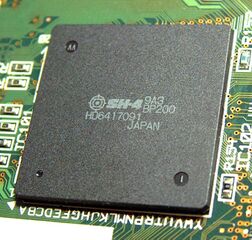SH-4
From Sega Retro

|
| SH-4 |
|---|
| Designer: Hitachi |
This teeny-tiny article needs some work. You can help us by expanding it.
The SH-4 is a RISC processor designed by Hitachi as part of the SuperH family. It is the main CPU in the Sega Dreamcast console and NAOMI, NAOMI 2 and Hikaru arcade platforms.
Technical specifications
- See Sega Dreamcast/Technical specifications for further information
- Operating frequency: 200 MHz
- Features: RISC, 2-way Superscalar,[1][2] parallel pipelining[3]
- Units: 128‑bit SIMD vector unit with graphic functions, 64‑bit floating‑point unit, 32‑bit fixed‑point unit, DMA controller[4] (frees CPU for other tasks),[5] interrupt controller[4]
- 128‑bit vector graphic computational engine (SIMD) @ 200 MHz: Vector unit, geometry processor, DSP, graphic functions,[4][6] 3D capabilities,[5] calculates T&L geometry and lighting of polygons, creates display lists of polygons for tiling, DMA allows SH4 access to VRAM and PowerVR2 access to Main RAM, store queue mechanism (allowing high‑speed packet transfers between Main RAM and VRAM)[7]
- Bus width: 128‑bit internal, 64‑bit external
- Bandwidth: 3.2 GB/s internal, 1.6 GB/s external
- Performance:
Documentation
Footnotes
References
- ↑ http://computer.org/micro/articles/dreamcast_2.htm (Wayback Machine: 2000-08-23 20:47)
- ↑ File:SH-4 Software Manual.pdf
- ↑ File:SH-4 Software Manual.pdf, page 187
- ↑ 4.0 4.1 4.2 File:SH-4 datasheet.pdf
- ↑ 5.0 5.1 Gamers' Republic, "August 1998" (US; 1998-07-21), page 29
- ↑ File:SH-4 Next-Generation DSP Architecture.pdf
- ↑ File:DreamcastDevBoxSystemArchitecture.pdf
- ↑ File:SH-4 Software Manual.pdf, page 5